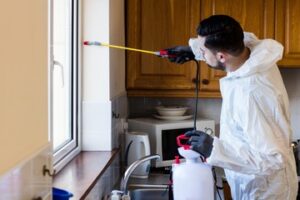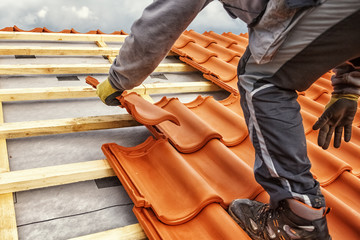Pest control involves protecting human property, food and crops from harmful insects and rodents. These pests cause damage to homes, businesses and gardens and can trigger asthma attacks, allergies and bacterial infections.

Licensing is important in this business to ensure you and your team are safe when handling regulated chemicals. Also, consider how you’ll market your business to attract and retain customers. Visit Our Website to learn more.
The first step in pest control is to try to prevent pests from entering the property. This may include removing food sources such as crumbs and spills, cleaning counters and tables on a regular basis and using bug zappers or screens on doors and windows. In addition, it is a good idea to inspect the property regularly for points of entry such as cracks and holes in walls, foundation and vents and to seal them with quality caulking or insulation material.
Another step is to remove water sources that may attract pests, such as puddles and standing water. It is also a good idea to remove overgrown vegetation that might provide cover or shelter for pests and to eliminate places where rodents can nest. Finally, to reduce the reliance on and risk from chemical treatments, preventive methods can be combined with reduced-risk treatment options. This is called Integrated Pest Management, and it has been shown to slash pesticide use by up to 90 percent while improving overall pest management.
Natural forces, such as climate and the presence of natural enemies, have a major influence on pest populations. The goal of pest control is to manipulate these factors to keep pest numbers low and avoid damage to plants, animals and structures.
Eradication is a rare goal in outdoor pest situations, but it can be attempted for certain invasive species such as Mediterranean fruit fly and gypsy moth. It is more common in indoor pest situations where it can be more easily achieved.
Biological pest control is the use of living organisms to help eliminate pests. This can include predators, parasites and pathogens. It also includes techniques that alter the environment to make it less favorable for pests, such as adding barriers or changing habitat. These methods can be quite effective in controlling some pests, but they take some time to work.
Pheromones are also used as a method of monitoring and controlling pest populations. A manufactured copy of the pheromone that a female insect uses to attract males can be introduced to confuse the males and prevent mating, thus lowering pest numbers. Juvenile hormones are also sometimes used to control pest populations by keeping some immature insects from maturing into normal adults and reproducing.
Suppression
Preventing pests and managing them when they occur is the goal of most pest control tactics. These prevention strategies can include things like cleaning up debris and waste piles that might attract rats, caulking cracks or repairing screens to prevent insects from entering a structure, and using crop rotation, fertilization and irrigation to reduce pest pressures.
When prevention fails or the pest population rises above an economic or aesthetic threshold, suppression strategies can be implemented. These methods reduce the pest numbers to acceptable levels by killing or affecting the behavior of the pest. This might include using trap crops (like zinnias) to lure Japanese beetles to a treatment area so they can be sprayed with insecticide, or spraying weeds with herbicides to kill them. The use of biological controls can also he useful in this situation. These are organisms such as birds, reptiles, fish, mammals, or insects that naturally prey on or parasitize pests, reducing their populations.
Eradication is a goal in very rare circumstances, especially in outdoor situations where pests can be transported long distances by wind or water. It is more common in indoor pest control programs, where the goal is to eradicate a specific pathogen such as a plant virus or an infectious bacterium.
In most natural populations, pests are regulated by density-dependent effects. Reducing the average number of progeny produced per adult by even a small amount can cause a large decrease in the population. This method is often called suppression or sterility control.
Weather conditions, such as rain or freezing temperatures, often directly affect the activities of pests by limiting their ability to reproduce or grow. Unusual weather conditions can affect pest activity in ways that are not predictable, so scouting and monitoring are important parts of any IPM plan.
Pests can be controlled in a variety of ways, from cultural practices to genetic engineering. These techniques modify the environment of the pest in ways that alter their life cycle or behavior, allowing them to be managed without harming other organisms. They can include things such as altering soil nutrients, changing light or air temperature or humidity, manipulating the availability of water, modifying the amount of available sunlight, or encouraging beneficial organisms to out-compete the pests.
Eradication
A pest infestation can be a big nuisance for homeowners. Pests not only cause damage to property but also pose a threat to health. They can spread diseases such as vector-borne diseases (like malaria or West Nile virus) and avian flu, as well as respiratory problems like allergies and asthma. Fortunately, there are several ways to control pest problems. One option is to use baits and traps. However, it is important to know what kind of trap or bait is best for the particular pest you are dealing with. This will ensure that you get rid of the pests and not innocent bystanders, such as pets or children.
Another way to eliminate pests is by using biological methods. These are a combination of natural enemies and plant hormones that disrupt the pest’s reproductive cycle. Another option is to use parasitic nematodes, microscopic worms that feed on insects. These nematodes are available in a number of species, some of which target specific pests such as fleas, grubs, and cockroaches.
Pesticides are often used as a last resort when all other methods have failed. It is crucial to know the potential risks of using chemicals, particularly around children and elderly people. Some chemicals are not only toxic to pests but can be dangerous for humans as well. Children, the elderly, and those with weakened immune systems are particularly vulnerable to harmful chemicals. It is also crucial to use a pest control product that targets the particular pest and is safe for humans.
The most effective way to eliminate pests is to remove the conditions that make them thrive. This includes removing any weeds or other plants that are crowding out the pest and keeping areas clear of debris that can serve as hiding places for them. It is also important to keep the environment clean and hygienic, as this can help deter pests from entering.
Eradication is a difficult task that requires careful consideration and planning. A number of eradication programs have been unsuccessful, especially those aimed at eliminating invasive alien species that compete with native species. The success of the Smallpox eradication program, however, has shown that eradication can be successful, and it is worth continuing to pursue this goal.
Monitoring
The effectiveness of pest control measures can be assessed through monitoring, which enables you to track the results of your treatment. It may involve regular inspections, the placement of traps or bait stations, or other methods for tracking pest activity. Regularly analyzing the data from these monitors helps you identify what types of pest pressure you’re experiencing and from which direction they may be coming. This information informs other pest control activities.
Conducting regular monitoring allows you to catch pest infestations early, so you can take preventive measures and limit the amount of damage caused. This is a core part of the Integrated Pest Management (IPM) approach, which focuses on preventing pest infestations and using non-chemical control techniques whenever possible.
For example, in museums, the presence of collection pests like psocids and fungus-eating plaster beetles tells you that the environment is too humid and not ideal for collections storage. Monitors can also be used to detect non-collection pests, such as rodents, and provide important information about the health of your building, such as how well your doors and windows fit and whether or not they are sealed.
The key to effective monitoring is to set clear goals and choose appropriate metrics. For example, for a museum, this might include tracking the number of pests caught or killed and comparing the results before and after treatments are applied. It’s also important to establish a baseline level of pest activity to evaluate the effectiveness of your pest control measures.
A baseline also helps you determine the effectiveness of preventative pest control strategies, such as keeping food in tightly closed containers and reducing clutter to minimize hiding places for pests. A good IPM program also includes educating employees on how to help prevent pest infestations and providing them with the tools to do so.
Finally, the implementation of exclusion tactics can keep pests out of a facility and structure. These might include installing self-closing warehouse or entrance doors, screening windows and doors, securing vents with metal strips, caulking cracks and crevices, and eliminating conducive interior conditions that allow pests to thrive.




